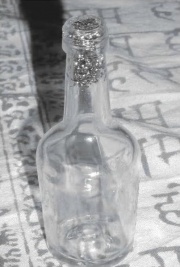|
|
| Line 9: |
Line 9: |
| | | | |
| | Material Considerations: | | Material Considerations: |
| − | * Copper may gradually turn black due to the formation of Copper(II) oxide (CuO). This reaction and its product are not detrimental to the process of administration. | + | * Copper may gradually turn black due to the formation of Copper(II) oxide (CuO), an inert solid. This reaction and its products are not detrimental to the process of administration. |
| | + | |
| | + | |
| | | | |
| | | | |
Revision as of 19:38, 21 January 2010
 |
Note: | This page has been transcluded to The Nexian DMT Handbook under the The Machine section or other locations within or without the handbook. Please markup in consideration of this. The top section header is to remain in place as a reference for subsequent section headers and to allow easy editing directly from the handbook. |
"The Machine"
"The Machine" is essentially a glass vaporizer in which heat is meant to distribute through the pipe rather than across the glass. It utilizes a metal mesh plug inside of the pipe, on which the product is to be placed, melted and vaporized. The mesh acts both as a screen and a heat-sink, simultaneously allowing for the even heating of the product and prevention from inhaling unvaporized particulates.
This method of vaporization includes the standard variations—which are essentially the simple combination of a vaporizing bowl and a vapor chamber with an inhalation nozzle—and the bubbler variation in which the vapor passes through a water heat-sink before reaching the vapor chamber and inhalation nozzle.
Material Considerations:
- Copper may gradually turn black due to the formation of Copper(II) oxide (CuO), an inert solid. This reaction and its products are not detrimental to the process of administration.
| the Improvisation of the Standard Variation
|
 |
- Obtain a glass piece with only two openings—one smaller than the other—accessing a single chamber.
- The most common method is to use a small bottle and drill a small hole in the bottom.
- Though a straight tube, such as a dropper stem, could be used, a larger vapor chamber may lend itself to a cooler vapor.
- Prepare a plug made of metal mesh by cutting a piece of an excess of the appropriate size to fit in the larger opening of the glass piece.
- Stainless steel and copper of a coarse mesh are preferable, as they do not tend to burn at the temperatures needed for vaporization.
- Using pliers to hold the cutting, use a torch to thoroughly burn off any machine oil or coatings found on the mesh.
- Perform this step until no more smoke can be observed emanating from the cutting.
- Allow to cool and roll the cutting tight enough to fit in the larger opening of the glass piece.
- The plug needs to be tight enough to suspend it in the opening but not so tight as to block air passage.
- Obtain an inhalation nozzle or mouthpiece of some kind if necessary to facilitate inhalation from the vapor chamber through the smaller opening in the piece.
- A tube or straw of some kind is the most common method.
|
| the Improvisation of the Bubbler Variation
|
 |
- This variation can apply to the use of a small bubbler pipes, bong-style bubblers, or improvised bubblers.
- smaller bubblers are often found most preferrable.
- One need only to follow steps 2-4 of the standard variation though in application to the bowl of a bubbler rather than an improvised glass-piece.
- The water in the bubbler acts only as a heat-sink and will not absorb a significant if any amount of product, as the freebase product is not very soluble in water.
- The use of ice in cooling should be forgone, as it may cause the premature precipitation of product within the chamber.
|
Further Elaboration and Technical Support
- "The Machine" Article from The Entheogen Review
- "the machine" Q.'s
